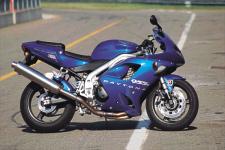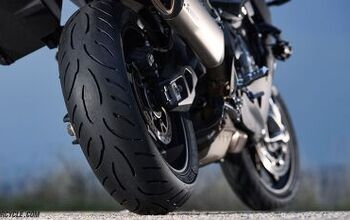Church of MO: 2002 Triumph 955i Daytona First Ride
For a while there it looked like Triumph wanted to play the superbike game with the rest of the world. But slimming down the 955i Daytona by losing its original one-sided swingarm, and other weight-saving measures, sometimes seemed more like cost-cutting ones. And maybe Triumph sensed the imminent demise of the superbike a bit earlier than some others. Screw it, let’s build Speed Triples instead, and maybe a smaller one as well… Herein, T. Rozenfeld damns the Daytona with faint praise: “Long live the British eccentricity!”
Italy, July 24, 2001 — If you’ve ever been to London you might recall those nasty little “near misses.” You look left before crossing a quiet road, proceed on and then come but a cat’s ass away from being flattened by a car coming from your right – the wrong direction.A long line of obscenities in a charming Cockney accent usually follows the sound of screeching rubber. No doubt about it, Brits do it differently and it’s not just driving on the wrong side of the road. Case in point: the all-new 955i Daytona. From its inception under the 595 moniker (changed later to 955 to avoid confusion), the Triumph flagship tried to mix it up with the likes of Yamaha’s YZF1000, Honda Fireblade and Suzuki GSXR750 with peculiar technical solutions.
In this world of monkey see, monkey do, any self-respecting manager would have analyzed the opposition, copy the good bits and try to do some better. But not so in England.
Back in ’97, the Daytona caused quite a stir if only because of Triumph’s courage to face the current Japanese hypersport bikes with such an original piece. “The opposition has four cylinders? Let’s go for three. They have a twin spar frame? Ours will do with funky oval tubes.
And just to make sure we’re different indeed, let’s throw into the equation fuel injection and
a single-sided swing arm.” But they had a point. In England, Fireblades had become so mundane by then, they rightfully sensed a need for a hypersport tool with tons of British character and, above all, different styling. The result was rather well received, but the final verdict was usually one that suggested the Daytona was in need of more power and a diet. Oh, but “it’s a nice first try.” With the 2002 Daytona 955i, Triumph’s engineering staff seemingly took the complaints seriously and endowed the new model with 19 more horsepower while sucking away some 22 pounds of the old model’s fat like so many Beverly Hills surgeons. The claimed 149 HP put the 955 shoulder to shoulder with the CBR while, in the weight department, it still lags behind the competition by some 15 to 30 pounds.
The welcome improvements in engine performance were achieved by implementing current racing four-stroke technology. The totally new cylinder head has had the included valve angle reduced from 39 to 24 degrees while the compression has been bumped from 11.2:1 to 12:1. These changes, combined with with enlarged throttle bodies (43 to 46 mm), make the new engine one hell of a screamer. The claimed 149 horses stampede at 10,700 rpm, relatively high engine speed even for a four cylinder engine, let alone a triple bore.
“Chassis wise, the main change is the conventional swingarm. As cool as the single-sided item looked, it weighed some 6.5 pounds more than the new one.”
The very sensual oval tubes frame got their steering angle pulled in from 24 degrees to 22.8 to alleviate the somewhat ponderous steering of the previous model. A host of other refinements such as new instruments, lighter front wheel, brakes and thinner fairing panels contribute to the loss of 22 pounds.
The previous model’s fairing received its fair share of criticism for mimicking too closely that classic Ducati 916 twin headlight look. Never mind that the same could be said about the R1. In many eyes, the old Daytona had a feline look that was quite unique. In this year’s remake, it got binned and a new, sharper shaped fairing covers the 955’s most intimate parts. In fact, this new haircut is quite becoming. But then, the designers also replaced the twin headlights with a huge unit that somehow reminds us of a ’93 750 GSX-R. Well, the huge reflectors sure look like they could forever blind an oncoming car driver, so it’s probably a change for the better.
By courtesy of Italy’s Triumph importer, Numero Tre, we get to test the 955 at the cute Varano track midway between Milano and Bologna. After warming up on other Triumph models on hand, we climbed onto the new Daytona. The riding position has definitely changed, especially in the handlebar department. The higher bars are kinder to your wrists than those of old and you can definitely see that the Honda Fireblade was between the designer’s crosshairs in the comfort department. The seat height is quite high though, with an arse-up-in-the-air style.
Upon starting the engine, the deep, stimulating three cylinder bark is all there, but now revs pick up a lot faster when playing with the throttle. Once off, even before we get to check for truth behind Triumph’s claims for peak power, there’s all that amazing mid-range power to sample. The hot rodding of the 955’s engine has not harmed that beautiful pull. Down low, the 955 feels R1-strong and kicks onto the main straight in a hurry. Further up the range it just goes on and on with the engine getting into its stride by 6,000 with peak torque coming along for the ride at about 8,000 rpm.
For the first tentative laps, all that torque sure helps as it’s easy to short-shift around the track, paying close attention to lines. I finally kick the 955 into the upper rev range and it responds with a superbly linear pull all the way to some wailing 11,000 rpm.
It feels a tad tamer and saner than a CBR, but then again, the linearity of the power delivery somewhat masks the true one liter rush that’s present in this new Daytona. Thankfully, we have not even one bad word to say about the fuel injection.
In the slow and technical esses of this track, there are quite a few on/off throttle situations but the response is seamless. It might not be as surgically precise as on a GSX-R750, but then this relative looseness in response works just fine for a non-racer.
Those little changes on the frame seem to work, too. The weight loss and reduced steering angle make the 955 a quick steering bike, although it’s still not Fireblade quick. The new swingarm held the plot well up to the point where the rear Bridgestone 010 cried enough under the punishment of a heavy throttle hand. No big dramas, it all remained under control. As good as the Bridgestones were, they’d be useless without proper suspension and plenty of ground clearance. In the fast right-left esses that had other bikes in the Triumph range wallowing around, the new 955 was steady. Not dragging anything on the track was beneficial, too. Good marks go to the fine brakes that had nice feel and power.
“Our only points of criticism on this track test were a slight heaviness while initiating turns with the brakes still on.”
Not that much of a problem, just do your braking while upright and trail off quickly as you get the bike turned in. The only other complaint had to do with the fact that the Varano track is not really a fast one. It’s a bit slow and technical, the sort that best suits the lighter, more nimble 600s. This created a problem in that the 955’s gearing wasn’t quite suited to the conditions.
Considering the fact that Triumph does not refer to the 955 as a “race replica,” its surprising how good a track tool it is. And for the same reason it looks like it should be an even better road bike. That doesn’t mean that Triumph created the perfect Fireblade or R1 carbon copy – quite the opposite. The 955i Daytona still has its very own, big Brit character. Its actually so good and unique as to make the little odds and ends that have an unfinished look forgivable. In fact, in Europe, the new Triumph even undercuts the competition price wise.
The fact that there is such an option for the Japanese offerings at a competitive price, is truly remarkable. And this new Triumph makes few concessions for the sake of owning something with “character” than anything preceding it. Long live the British eccentricity!
Specifications:
Engine : Liquid-cooled, DOHC, in-line 3-cylinder Capacity : 955cc Bore/Stroke : 79 x 65mm Compression Ratio : 12:1 Fuel System : Multipoint sequential electronic fuel injection Ignition : Digital – electronic engine management system Transmission : Wet, multi-plate, 6-spd. Frame : Tubular, fabricated aluminum alloy perimeter Front Wheel : 17 x 3.5in Rear Wheel : 17 x 6.0in Front Tire : 120/70 ZR 17 Rear Tire : 180/55 ZR 17 Front Suspension : 45mm forks with dual rate springs and adjustable preload, compression and rebound damping Rear Suspension : Monoshock with adjustable preload, compression and rebound damping Front Brakes : Twin 320mm floating discs, 4 piston calipers Rear Brakes : Single 220mm disc, 2 piston caliper Length : 2072mm Height : 1165mm Seat Height : 815mm Wheelbase : 1417mm Rake/Trail : 22.8°/81mm Weight (Dry) : 188kg Fuel Capacity : 21 liters Claimed Torque : 100Nm at 8,200 rpm
More by John Burns


































Comments
Join the conversation
I've hoped for years they would bring us a modernized version of this 955i. The closest they have come is the new Speed Triple RS, and it is a worthy effort, but it's not quite the same.
Still one of my favourites , a very fine machine which was a blast to ride , and the sound from the aftermarket silencer was pure heaven